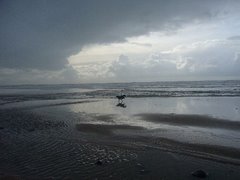On Saturday 5th June the Sydney Opera House hosted a concert for dogs as part of the “Vivid” Light Festival. Organised by American musician Laurie Anderson and her rock legend husband Lou Reed, the Music For Dogs event featured a surreal concerto of high-pitch whistles, synthesizers and strings.
This is how the Sydney Opera House’s website presented the event:
“The World Premiere of a unique concert experience on the Sydney Opera House Forecourt, for you… and your dog!
Laurie Anderson has composed a 20 minute work to create a shared experience for you and your dog.
The morning will be an inter-species social gathering on a scale never seen before in Australia. The site will open from 9am where breakfast can be purchased at our specially created doggie cafe, including freshly brewed coffee, egg & bacon rolls and doggie biscuits. This is an event that you’ll be yapping about for years to come, an absolute must for any dog and their two legged friends!
Unfortunately there is no public transport for you and your dog, however the Sydney Opera House car park is dog friendly and offers you a $15 flat rate for this event!
The wet weather contingency venue will be under the Sydney Opera House vehicle concourse.
ALL DOGS MUST BE ON LEADS.”
And this is what the press had to say after the event:
“The program did not go as far as listing The Barker of Seville or The Marriage of Fido, but for the hundreds of dogs who gathered at the Sydney Opera House, it was still an unusually cultured day out.
While some of the pieces were beyond the range of human ears, they sent the concert's four-legged patrons into a frenzy.
"It was really so fantastic. All the dogs were really grooving on the music. They really seemed to enjoy themselves," said Ms Anderson.
The 20-minute concert opened with a set featuring whale calls and soothing white noise, before moving through a rhythm and beat section to a discordant crescendo almost drowned out by hundreds of barks and howls.
"We've got some singing dogs down here in the mosh pit (*)," joked Ms Anderson, who led the four-piece band with a variety of instruments including slide whistle, violin and synthesizers. Organizers said that dog owners brought around 1,000 pets to enjoy the free event.
"The dogs were really wonderful audience members," Ms Anderson added. "And there were no dog fights. We were very relieved about that, everyone was very well behaved."
(*) For those of you less familiar with “youth speak” here is the definition of mosh pit: “Moshing refers to the act in which audience members at live music performances push and/or slam into each other for the purpose of fun activity and in a non-hateful way most of the time. It is most commonly associated with concerts featuring more aggressive musical genres, such as hardcore punk and heavy metal.
Moshing primarily takes place at live shows, though it can be done to recorded music. In the 2000s, many variations of moshing exist, such as "thrashing," and is typically done in an area in front of the stage which is referred to as the mosh pit or simply pit.”









